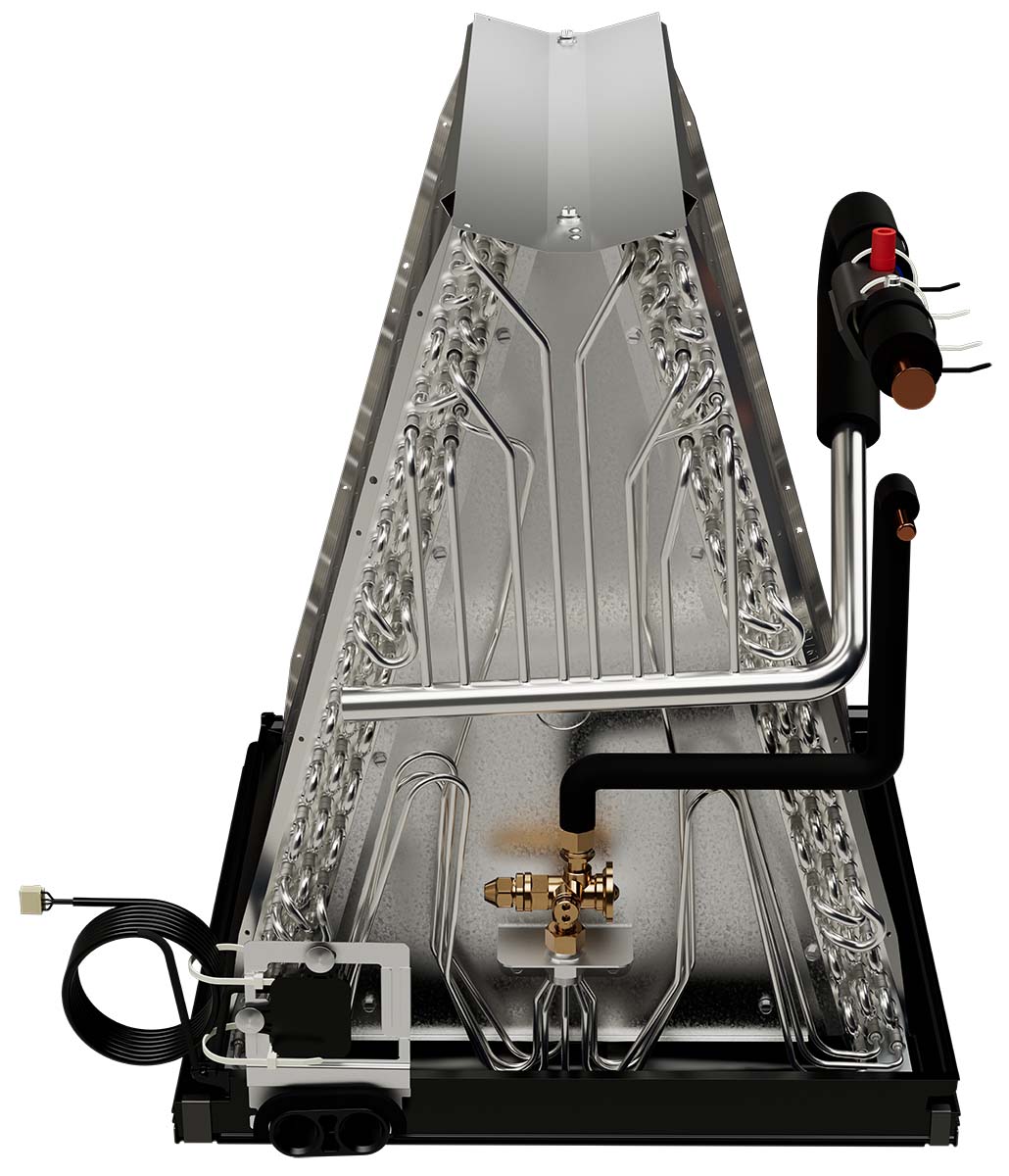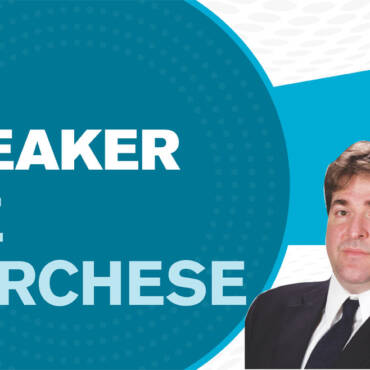✕
The HVAC industry is undergoing another refrigerant transition due to federal legislation known as the AIM Act, which mandates the phasedown of high-GWP refrigerants like R-410A. That means by the end of 2024, manufacturers must transition their new comfort cooling equipment to utilize lower-GWP refrigerants like R-32 or R-454B, which ASHRAE classifies as being mildly flammable (A2L).
Due to their mildly flammable nature, safety features like refrigerant detection systems (RDSs) are being incorporated into the new, residential/light commercial, ducted split systems, per safety standard UL 60335-2-40. The RDS detects specific refrigerants at predetermined concentration thresholds and triggers mitigation measures if that threshold is exceeded.
RDSs are generally required in A2L systems that contain more than 4 pounds of refrigerant and can either be field or factory-installed, depending on the manufacturer. The RDS from Johnson Controls was detailed in a previous article, while Carrier, Daikin, and Trane provide insights into their systems below.
Carrier
Like most manufacturers, Carrier’s RDS consists of two main components: a refrigerant sensor and a control board. According to Matt Vargo, strategic product manager at Carrier, these two components will be factory installed in fan coils, with the control board mounted in the fan coil control and the sensor positioned lower in the coil. In furnace coils, the control and enclosure must be field-mounted outside the ductwork, but all necessary components will be included with the product.
“The control board’s function is to intercept the thermostat signals and issue an override in the event of a detected refrigerant leak. The control will also dissipate leaks without a thermostat call,” he said. “If there is a concentrated refrigerant leak detected, the system will turn on the blower, which will run while the sensor continuously checks for high concentrations until it stops sensing a leak. At that point, the RDS will run for a few additional minutes to ensure there is not a high concentration of refrigerant in the system.”
Carrier’s RDS will be wired between the indoor unit and the thermostat, so the thermostat signal is passed through unchanged during normal operation. In the event of a detected leak, the RDS will change the thermostat call to a constant fan call, and any call for heating or cooling will be removed. Once the dissipation cycle is completed, the equipment will resume normal operation.
“Our communicating systems will have a notification displayed on the user interface to alert the homeowner to contact a service provider,” said Vargo. “Dealers will also be notified of any system that is connected to our dealer portal. An optional audible notification is available for purchase and can be installed on a dry contact provided on the RDS control. There are also error code readouts on the RDS.”
Carrier will ship all ducted fan coil and furnace coil systems that have a total charge between 3.9 and 34.7 pounds with an RDS. Vargo noted that Carrier’s RDS does not require any unique maintenance and is designed to last the life of the unit.
“Regularly scheduled maintenance for the system will service the RDS as well, ensuring that the system responds to a dissipation signal from the sensor,” he said. “Regarding monitoring, the sensor and control will indicate issues with miswiring and sensor communication issues, among others. All error codes will be stored in the control for easier diagnosis.”
In the unlikely case of failure, Vargo said that the RDS can be replaced in the field. He noted that if the sensors fail and need replacing, the RDS will default to the dissipation cycle; in the event of a power failure, calls from the thermostat will be removed, and a no heat/cool condition will occur.
“Carrier has designed an RDS that is simple to install, understand, and troubleshoot,” said Vargo. “All connections are made at the indoor unit as expected, and all connections are identified and/or labeled in several ways to simplify the installation and service of the equipment.”
Daikin
At Daikin, the RDS consists of three critical components: 1) the sensor that constantly “sniffs” for leaks and is factory installed on the coil drain pan near the drain ports; 2) a mitigation printed circuit board (PCB) that is mounted on the air handler or furnace controls section; and 3) wire harness that connects the sensor to the PCB, said Yateen Sukhtankar, product manager at Daikin Comfort Technologies North America Inc.
“The RDS is now factory installed on all new A2L air handlers, furnaces, and cased coils,” he said. “For example, when you look at the Daikin Fit system, the evaporator coil will have a factory-installed sensor that will connect directly to the inverter-tuned PCB within the air handler or furnace. There is an RDS kit that can be field installed as well, and that comes with its own installation instructions for the technicians to follow.”

FACTORY INSTALLED: Daikin’s sensor is factory installed on the coil drain pan near the drain ports. (Courtesy of Daikin)
Once the RDS detects a leak, the sensor will send a signal to the mitigation PCB, which in turn, will send a signal to the outdoor unit, which will shut off the compressor and the flow of refrigerant. This helps prevent any additional refrigerant from circulating through the system. The mitigation PCB will also send a signal to the indoor fan motor to be in continuous “on” mode, so that air can flow across the indoor unit, helping to dissipate leaked refrigerant from pooling within the indoor unit.
“When a leak is detected by the RDS, an LED light on the mitigation PCB will flash for a predetermined number of times as described in the installation manual,” said Sukhtankar. “This allows the technician to decode the fault. The unit will continue to run in a refrigerant mitigation mode, as described above, until the RDS no longer senses a leak. If a leak is no longer detected, the unit will return to normal operation. All new Daikin ducted systems are designed to comply with these safety mechanisms.”
Daikin’s RDS is designed to last for the lifetime of the system, although it can be replaced in the field if it fails, said Sukhtankar. Maintenance will be no different than what is required for the system in general, unless dictated otherwise by local codes for different regions. If any issues occur with the RDS, the mitigation PCB will display error codes to help diagnose the problem. The installation manual provided with the unit will help the technician with the diagnosis.
“There are no backups to the RDS, so if there is a power or sensor failure, the system will shut down,” said Sukhtankar. “This, in turn, will stop the flow of refrigerant through the system, thus preventing a potentially hazardous scenario from occurring.”
– Sean Goddard
product manager
Trane Technologies
Trane
Trane’s RDS consists of two main components: a sensor to determine if a leak is present on the indoor coil and a mitigation control board to tell the system what to do if a leak is detected, said Sean Goddard, product manager at Trane Technologies.
“Any air handler, furnace coil, or packaged unit with 4 or more pounds of refrigerant charge must have an RDS,” he said. “For simplicity, Trane has decided to include the sensor and mitigation control board on all residential air handlers and cased coils. That way, the dealer does not have to charge the system to determine if they need to add an RDS based on the system charge.”
That means Trane’s RDS is factory-installed on all Trane Technologies-manufactured indoor equipment. The cased coils will contain all needed RDS components, so Trane furnaces will not see any physical changes from this transition, meaning new A2L equipment can be installed with existing furnaces.
Since A2L refrigerants are heavier than air, they will pool at the lowest point. Goddard said that to detect a refrigerant leak effectively, the sensor needs to be mounted at the lowest point below the evaporator coil. For that reason, the sensor will be installed on the indoor coil’s drain pan. With a patented clip to secure the sensor to the drain pan, he said that a technician can easily relocate the RDS sensor as may be needed in alternate install orientations.
“For split air handlers and cased coils capable of being installed in multiple orientations such as downflow or horizontal, the sensor comes factory configured for the upflow system orientation,” he said. “For other orientations, technicians should consult the detailed installation guidelines included in the installer’s guide shipped with the unit.”
Goddard added that Trane’s goal was to keep this system simple and safe for their dealers and technicians. “Our RDS supports both 24V and communicating HVAC system controls, meaning if a technician carries one in order to monitor the A2L sensor and one control board, they can repair and service any of our equipment.”
If a leak is detected, the RDS de-energizes the compressor and other electrical devices and starts the indoor fan to disburse the refrigerant. Illuminated LEDs on the mitigation control board will indicate to the dealer if a mitigation cycle has occurred, and an optional audible alarm is available for homeowners. Communicating systems will also have notifications on the thermostat. Once the sensor no longer senses refrigerant, the system will return to normal operation. Furnace and electric heat operations are not affected by refrigerant leak mitigation activities and will continue to operate as normal.
Goddard said Trane’s RDS sensor does not require calibration during its lifespan, and the sensor will last the life of the unit.
“Because these new A2L refrigerants have different handling requirements than what has existed in the past, new product labeling and markings will be used to help installers and service technicians differentiate these units,” said Goddard. “In Trane’s case, service ports and line set connections will have highly visible red markings to note that the unit has A2L refrigerant. The equipment has been updated to provide a seamless installation experience for the service technician.”
Whether you require installation, repair, or maintenance, our technicians will assist you with top-quality service at any time of the day or night. Take comfort in knowing your indoor air quality is the best it can be with MOE heating & cooling services Ontario's solution for heating, air conditioning, and ventilation that’s cooler than the rest.
Contact us to schedule a visit. Our qualified team of technicians, are always ready to help you and guide you for heating and cooling issues. Weather you want to replace an old furnace or install a brand new air conditioner, we are here to help you. Our main office is at Kitchener but we can service most of Ontario's cities
Source link



Add Comment